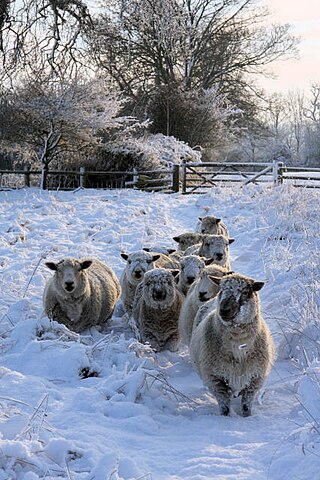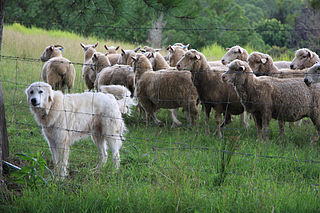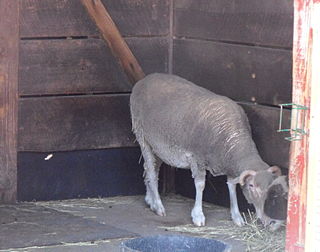Related Research Articles
Breed clubs are associations or clubs with activities centered on a single, specific breed of a particular species of domesticated animal. The purpose of the association will vary with the species of animal and the goals and needs of the members of the association. Breed associations or clubs may vary in their goals, activities and nomenclature from country to country, even for the same breed. Most domesticated animals, whether they are agricultural animals such as cattle, llamas, poultry, sheep and pigs, or companion animals such as pigeons, horses, cats and dogs, have breed clubs associated with the breed.

The Navajo-Churro, or Churro for short, is a breed of domestic sheep originating with the Spanish Churra sheep obtained by the Diné around the 16th century during the Spanish Conquest. Its wool consists of a protective topcoat and soft undercoat. Some rams have four fully developed horns, a trait shared with few other breeds in the world. The breed is highly resistant to disease. Ewes often birth twins, and they have good mothering instincts. This breed is raised primarily for wool, although some also eat their meat.

The Ryeland is one of the oldest English sheep breeds going back seven centuries when the monks of Leominster in Herefordshire bred sheep and grazed them on the rye pastures, giving them their name. It was introduced into Australia in 1919 and are classified as an endangered breed by the Rare Breeds Trust of Australia and also are one of the nine heritage breeds that were the foundation of the sheep and wool industry in Australia. The Ryeland was one of the breeds used to introduce the poll gene to the Dorset breed in the development of the Poll Dorset. This breed is raised primarily for meat.

Polled livestock are livestock without horns in species which are normally horned. The term refers to both breeds and strains that are naturally polled through selective breeding and also to naturally horned animals that have been disbudded. Natural polling occurs in cattle, yaks, water buffalo, and goats, and in these animals it affects both sexes equally; in sheep, by contrast, both sexes may be horned, both polled, or only the females polled. The history of breeding polled livestock starts about 6000 years BC.

The Livestock Conservancy, formerly known as the American Livestock Breeds Conservancy (ALBC) and prior to that, the American Minor Breeds Conservancy, is a nonprofit organization focused on preserving and promoting rare breeds, also known as "heritage breeds" of livestock. Founded in 1977, through the efforts of livestock breed enthusiasts concerned about the disappearance of many of the US's heritage livestock breeds, The Livestock Conservancy was the pioneer livestock preservation organization in the United States, and remains a leading organization in that field. It has initiated programs that have saved multiple breeds from extinction, and works closely with similar organizations in other countries, including Rare Breeds Canada. With 3,000 members, a staff of eleven and a 19-member board of directors, the organization has an operating budget of over a million dollars.

The Portland is a sheep breed that takes its name from the Isle of Portland in Dorset, England. This breed is raised primarily for meat.

A livestock guardian dog (LGD) is a dog type bred for the purpose of protecting livestock from predators.

The Castlemilk Moorit is a rare breed of domestic sheep originating in Dumfriesshire in Scotland.

Hog Island sheep are a breed of sheep descended from animals first brought to Virginia's Hog Island in the 18th century. During the 1930s and 1940s, storm conditions forced the island's residents to evacuate, leaving some sheep behind. These sheep adapted to the environment free of human intervention, becoming feral.

Santa Cruz sheep are an extremely rare breed of domestic sheep that once existed as a feral population on the Santa Cruz Island of the Channel Islands of California. Small and hardy, the sheep were all killed or removed from the island to prevent destruction of natural habitats. Today, they number fewer than 200 animals. This breed is primarily raised for wool.

Sheep or domestic sheep are a domesticated, ruminant mammal typically kept as livestock. Although the term sheep can apply to other species in the genus Ovis, in everyday usage it almost always refers to domesticated sheep. Like all ruminants, sheep are members of the order Artiodactyla, the even-toed ungulates. Numbering a little over one billion, domestic sheep are also the most numerous species of sheep. An adult female is referred to as a ewe, an intact male as a ram, occasionally a tup, a castrated male as a wether, and a young sheep as a lamb.

The Llanwenog is a breed of domestic sheep originating in Wales. It was developed in the 19th century from the Llanllwni, the Shropshire, Welsh Mountain, and Clun Forest breeds. The Llanwenog's native locale is the Teifi Valley, in western Wales, but it has since spread into other areas. The breed association was formed in 1957. Llanwenogs have black faces and medium-length wool. They have a docile temperament and are known for their profligacy in lambing. The breed has a very placid temperament, is easily handled, easily contained and is well suited to stress free inwintering if necessary. This has important consequences for the health of both the animal and its keeper. This breed is raised primarily for meat.

North Country Cheviot is a common breed of sheep raised mainly for meat production. Originated from Scotland.
The West African Dwarf or Djallonké is an African breed or group of breeds of domestic sheep. It is the dominant breed of West and Central Africa. This breed is primarily raised for meat. The Cameroon or Cameroon Dwarf is a breed within this group.
The Rideau Arcott is a breed of domestic sheep native to Canada, one of only a few livestock breeds native to the country.

The history of the domestic sheep goes back to between 11,000 and 9,000 BC, and the domestication of the wild mouflon in ancient Mesopotamia. Sheep are among the first animals to have been domesticated by humans. These sheep were primarily raised for meat, milk, and skins. Woolly sheep began to be developed around 6000 BC. They were then imported to Africa and Europe via trading.

The Red Maasai is a breed of sheep indigenous to East Africa. True to its name, the breed is kept by the Maasai, though both pastoralists and smallholder farmers in Kenya, Tanzania, and Uganda keep Red Maasai flocks.
References
- 1 2 "Waziri". Breeds of Livestock. Oklahoma State University, Dept. of Animal Science. Retrieved 2009-05-07.
- ↑ Microlivestock: Little-Known Small Animals with a Promising Economic Future (1991)
- ↑ "Breeds of Livestock - Waziri Sheep — Breeds of Livestock, Department of Animal Science". afs.okstate.edu. Retrieved 2022-01-01.